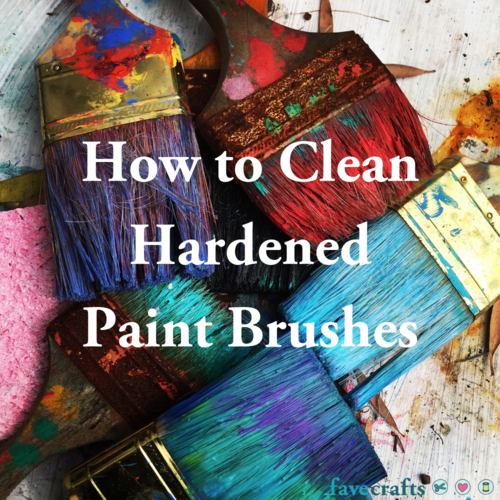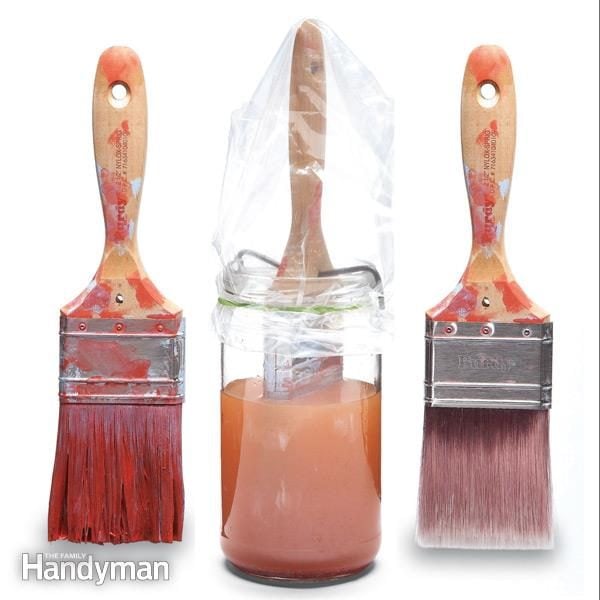Cleaning Dried Paint Brushes
- Cleaning Hardened Paint Brushes With Vinegar
- How To Clean Old Paint Brushes
- Cleaning Dried Paint Brushes
- How Do You Clean Dried Paint Brushes
Haven't any of you had any professional training at all?
If the dried paint is oil-based, begin this step by pouring turpentine onto the stained bristles. Alternatively, if the dried paint is water-based, you'll need to rinse your brush beneath a faucet. When using a faucet to rinse the brush, make sure the water temperature is lukewarm. Once the vinegar is boiling, take the paint brush by the handle and dip the bristles in the water. Push them back and forth on the bottom of the saucepan, imitating brush strokes. You need to remove the brush from the vinegar every 15 seconds to 20 seconds and see how the bristles are cleaning up.
Cleaning Hardened Paint Brushes With Vinegar
I don't want to steal your thunder Kelly, but this is not Best Practice.
Don't ever put paint thinner into plastic. It will melt most kinds. Why risk a mistake? Old glass salsa jars exist for brush cleaning. label one, put some glass marbles like the flower arranging ones into the bottom to work the brush against. (Plain, not coated with shiny stuff. It'll dissolve) Trying to clean oil based paints out of brushes by just stirring them around doesn't work. If you're desperate a crumpled piece of window screen will work too but it's hard on bristles so this is not a default. Paint thinner is very flammable and an ugly toxin so you want to keep it stingy and the stuff needs to go to Hazardous Waste Disposal. Wipe those brushes really well!
If you're doing fine arts painting go buy a proper brush cleaning pot. A big size one would be good for pro house painters. Solvent sits in it for weeks and it has a sieve to work the bristles over. Paint solids drop below it. The top keeps fumes in and evaporation almost nill over weeks. Minimal exposure, clean brushes. Now wash them! I wash up to thirty brushes a day in the studio; it's just doing the dishes.
Do NOT use a surfactant/ detergent 'soap'. Use a real soap, a chemically designated soap, with oil or fat in it. You can put it on a cellulose sponge and work the brushes across it to work up a lather, or just work them against your palm. If you use bar soap swipe the brushes across it. The soap cuts the oil, and the fat base conditions the bristles.If you wiped out the paint and rinsed in thinner properly there's very little to wash out. More like a post gym shower then wrestling gunk. You don't want paint in a sink drain or on the back patio. Rinse well. If you do this correctly you'll get to wear brushes out instead of throwing them away. And bristles are chosen for this exposure so they'll get better. It's just like washing your hair. Squeeze out the water and shape them, air dry.
This works for synthetic brushes too. Do not leave soap in the bristles as it will contaminate your paint next time and make a bad paint film. As for exotic paints like epoxy? Yes, use nitrile gloves and a respirator! Outside. But if the stuff is hydrocarbon based a fat soap should work too. Acetone on brushes will kill them fast, so make sure thats a really Best Practice. Again- a soap may work better. Most bristles need the conditioning.
If your brushes start to get that gunky icky feeling, soaking them in that inexpensive liquid oil soap from the grocery store (Also best for regular washing after painting) is like a spa treatment. Leave them in for two or three days. It's magic! Paint in the ferules is a ruined brush, but as regular maintenance this is amazing. I have ten year old mongoose thats still sweet. I also paint a lot.
Do not use soap on watercolor brushes. Just rinse.
This is the method professional painters use; It keeps solvent use to an absolute minimum. Reusing a cup or 12 ounces of thinner instead of blowing through gallons of it reduces exposure and that stuff has lead in it. Among other scary things. Don't use it on skin either. Paint'll fall of in 48 hours if soap or olive oil doesn't get rid of it.
Even if you use a thinner only system like the guys who paint cars using industrial paints, a cleaning pot will use less thinner and reduce your chemical exposure. They can be used in series. You can eyeball them at the big online art supply stores, and I shop at industrial supply so don't think they don't interchange. ;-D I'll try to post instructions for the homemade version.
Follow these simple steps to properly clean paint brushes after your next do-it-yourself project.
How To Clean Old Paint Brushes
Photo: istockphoto.com
An investment in high-quality paint brushes is wasted if they are not properly cleaned and stored after use. Indeed, rushing through the end of a paint job can leave you with flecks of paint in your brushes—which will lead to an imperfect finish on your next project—as well as misshapen bristles. So invest the extra two minutes it takes to do the job right and follow this guide on how to clean paint brushes.


MATERIALS AND TOOLS Available on Amazon
– Newspapers
– Mineral spirits
– Turpentine
– Mild liquid dish soap
– Small plastic buckets
– Paint brush and roller spinner
– Rags
The Right Way to Clean Paint Brushes

Cleaning Dried Paint Brushes
Photo: istockphoto.com
How Do You Clean Dried Paint Brushes

- Use up what paint remains on your brush on whatever you are painting.
Press the bristles against the inside of the paint can, and lift it up and out as you do—that will squeeze out more paint. Paint away the rest on newspapers, because cleaning a brush is made easier if you remove as much of the paint from its bristles as possible. - Next, examine the can of paint, and use the appropriate solvent.
The right solvent makes the job easy by loosening dried paint, but the wrong one will probably be no help at all. Fill a small bucket with one of the following depending on the type of paint you’ve used:- Mineral spirits or turpentine to remove oil-based paint
- Hot water and mild liquid dish soap to clean paint brushes that have been used to apply latex paint
- Immerse the paint brush in the solvent.
Stir the solvent with the brush for about 10 seconds, wiping and squeezing the bristles on the sides of the container. Work the bristles between your fingers, and run a brush comb through them to remove excess paint without damaging the bristles. If some of the paint has begun to dry on the brush, soaking the brush may be necessary. - Wash it in warm soapy water in a utility sink or bucket.
Once the paint has been removed from the brush, warm soapy water will clean the brush of the solvent and remaining paint. - Shake or spin the paintbrushes dry.
Before you store your paint brushes, you’ll want to remove all of the water from their bristles. Many DIYers will do so by shaking the brush at the top of a bucket and then blotting the brush dry with a clean rag or newspaper.But, for those that have plans to do a lot of painting and wish to preserve their tools, a brush and roller spinner will come in handy. This dual-purpose tool will speed-dry either type of paint applicators using centrifugal force. Just attach a paint brush to the bottom of the tool, then pump the top several times to spin it and fling all water off the business end of the brush.
- When storing paint brushes, hang them up or lay them flat.
Hanging paint tools from a pegboard in your workshop or craft room is not only a great organizational method, but it ensures that the brush’s bristles don’t get bent out of shape stuffed in a bin somewhere. Replace the packaging on your paint brush to maintain its form and prolong its useful lifespan.
Photo: istockphoto.com
